Updated: 13-Feb-2020
In 1909, Pierre Clerget was one of the most specialized engineers in aviation engines.
-After his visit to the 1889 Exhibition, Pierre, a teenager, realized his engine vocation.
-There were the first Daimler and DeDion-Bouton internal combustion engines.

"Clerget 4V engine"
-He began to think about their application in aviation and after testing and building, already in 1900, his four-cylinder engines appear in viable line.
-In 1910, one of his engines is mounted on the "Zodiac" airship.
-Before, in 1908, the four-cylinder inline 4V model engine gave 50 CV at 1,650 rpm rising to 63 CV at 1,800 rpm. It had steel cylinders and red-copper water circulation sleeves that were obtained by electrolysis.
-His 8-cylinder engine seems to be the coupling of two 4Vs. This engine (8V) gives 100 CV.

"Clerget cross section diagram"

"Clerget 8V, 100 CV"
-The automobile derived 4V was used on the "Etrich", "Deperdussin", "Libelulle", "Hanriot" and the "Coanda" turbine (in fact a propeller in a tube).
-In turn, it served as a guide for the 100 CV 4W.
-In 1910, at the Paris Salon Clerget presented, the 8W for airships, built in collaboration with Societé Malicet et Blin, giving 200 CV at 1,300 rpm.
-The Clerget rotary 7Y engine is from 1912. It was air cooled and gave 60 CV at 1,200 rpm and it was used in a Clementi-Bayard aircraft.
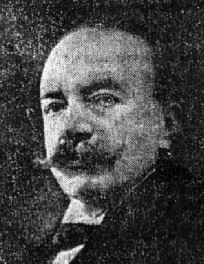
"Pierre Clerget"
-The 7Z raised to 85 CV at the same maximum revolutions of the 7Y. The nominal power was 80 CV.
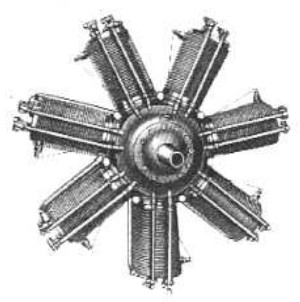
"7Z, 80 CV"
-The 110 CV was a nine-cylinder that used the same cylinders as the 7Z. The 9Z, giving 120/123 CV, depending on 1,200 or 1,300 rpm.
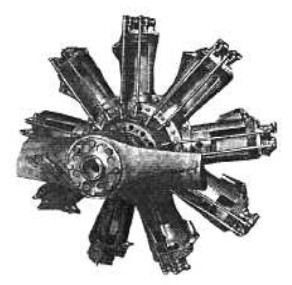
"Clerget 9B"
-In World War I (around 1916-17) they presented the 130 CV air-cooled rotary 9B engine that was identical to the initial 60 CV, but with the power increased because of the cylinder size, especially the stroke which was 160 mm instead of 120 mm, and by the number of cylinders, which went from 7 to 9.
-The pistons were made of aluminum alloy (it is said that they were the first aluminum pistons in the world, but so says Bentley of theirs.) See Clerget-Humber BR.1.
-In fact they are the same engines, or almost. They were installed on the Nieuport XVII and the Sopwith Caudron G3 and G4.
-The 9B was a successor of the 9Z giving 130 CV. The high compression version reached 153 CV.
-Also made in England by the Gwynnes, in quantity.
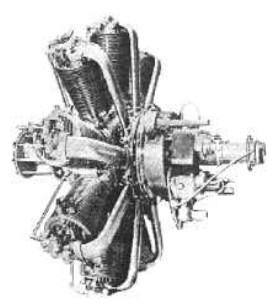
"Clerget 130 CV"
-Towards 1917 they present an extraordinary radial rotary engine: type 11Eb, that gave 200 CV. It had 11 cylinders in a single row.

"Clerget 11 Eb, semifrontal"
-It was a study engine of an unusual concept that was tested on a Nieuport. This engine was an 11D derivative that has only been bench tested.

"Clerget 11Eb, rear angle"
-The engines currently treated have 7, 9 and 11 cylinders, but there were also rotary engines with 14 cylinders. An experimental 300 CV rotary 18-cylinder was made as well.
-But from this series we have to highlight others like the 100 CV and 130 CV ones.
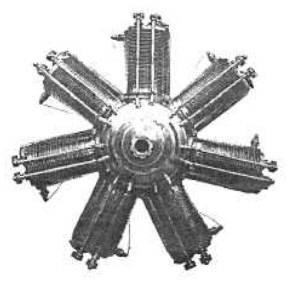
"Clerget 100 CV"
-Clerget's first radial rotary engines were distinguished by the twin rods in front of, and parallel with each cylinder, controlling the two valves on the cylinder head.
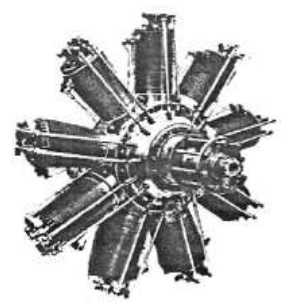
"Clerget 130 CV"
-In 1920 appears a great small one, the 16 CV "2K Type", which is known as the "Twin".
-Horizontally-opposed two-cylinder for light aviation in the postwar period.
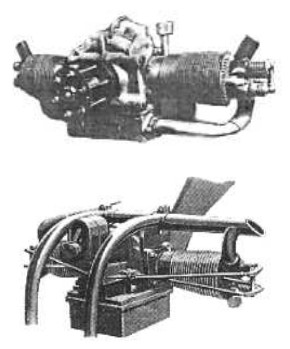
"2K, front and rear"
-Mounted on the small Dewoitine aircraft, it made the double crossing of the English Channel on May 6, 1923 with pilot Bardot.
-It was in this period that Clerget entered the field of 4-stroke diesel engines.
-Many were derived from the rotary engines by the inertia of their previous works, but as a stationary radial.
-The first to be installed on an aircraft, as a test, was a V-8 that gave about 300 CV.

"Clerget V-8"
-The Clerget 9A engine with direct injection gave 100 CV of power.

"Clerget 9A"
-The 9A Diesel, like the 9B, had a direct injection system for Diesel fuel, or "heavy oil" (huile lourde) as it was called at that time when compared to light gasoline.
-Both engines had individual injection pumps, one for each cylinder at the rear of the engine.
-As we will see, as from the 9C engine, the set of injection pumps passes to the front.
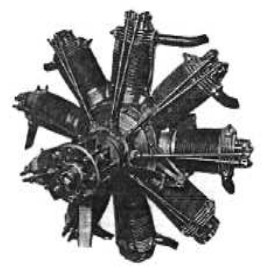
"Clerget 9B, Diesel"
-Without seeing them physically, there is confusion between the 9B rotary and the 9B Diesel from 1930.

"Clerget 9B, Diesel, cross-section"
-In this cross-section we can see how the valve distribution is at the front, and the individual cylinder pump at the rear.
-The above and below mentioned radial Diesel engines were provided with individual high-pressure injection pumps, instead of the automotive "monobloc" we have known, or more modern ones like Rotomaster, etc. They were driven by a cam-plate system, similar to the one that controls the valves.
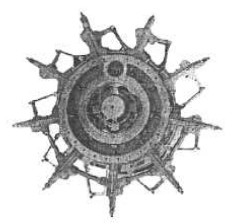
"Injection pump set"
-The 9B Diesel version is from 1930 and gave already 200 CV. The 300 CV 9C from 1932 was also made by Hispano Suiza in France, under license and denominated "9T".
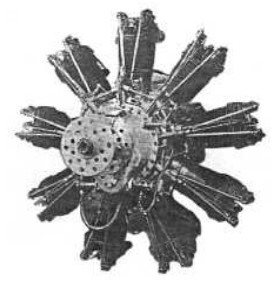
"Clerget 9C"
-As we will see later in Hispano Suiza, they not only made the 9C and 9T, but the agreements went further. They also made the 14-cylinder that was designated 14U.
-It was not common for Hispano Suiza to build radials.
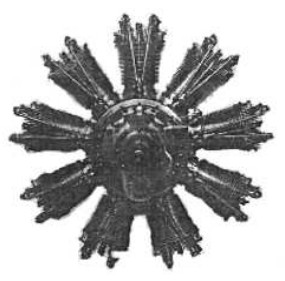
"Clerget 9T from 1932"
-As from the 300 CV, they changed to double row engines, that is, the 400 CV, 14-cylinder 14D in 1933.
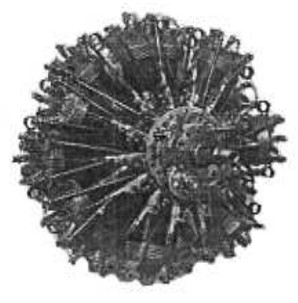
"Clerget 14D"
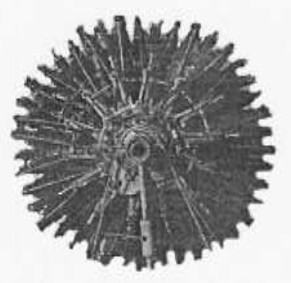
"Clerget 14E"
-The double-row, 14-cylinder 14Di model that used Diesel fuel and gave 500 CV is presented below.
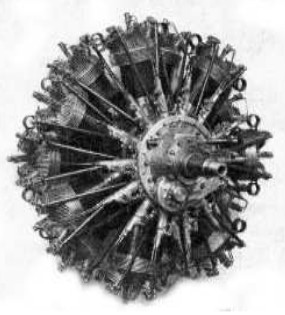
"Clerget 14 Di, magnified picture"
-The 14E gave 450 CV, and was from 1934.
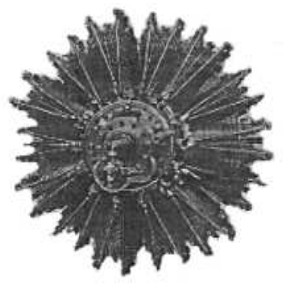
"Clerget 14F"
-The 14F reached 500 CV (in 1933) and had derivatives.
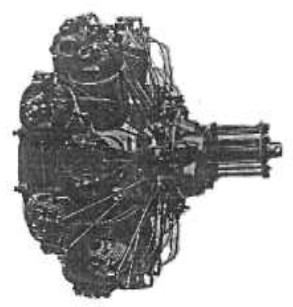
"Clerget 14U"
-The Clerget 14U with 500 CV was also manufactured by Hispano Suiza.
-These engines that were made in collaboration with Hispano-Suiza, although it was E.Clerget's design, finally became known as Clerget-Hispanos.
-On the 14-cylinder the piston diameter increased from 130 to 140 mm, maintaining the same stroke of 170 mm as the 9-cylinder diesel radial engine.
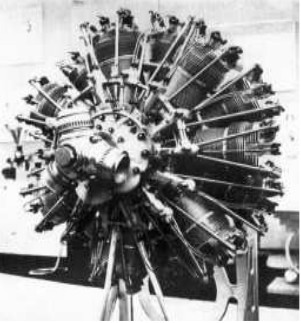
"Clerget-Hispano, 14-cylinder Diesel"
-It had a power of 500 CV at 1,900 rpm increasing to 640 CV at 2,200 rpm.
-The reference to the 9-cylinder and having taken their cylinders as a base, enlarged by an inch of interior radius, brings us to this engine in a new photograph.
-In between the V that is formed by the two valve rods is an individual injection pump from which the high pressure conduit leads towards the cylinder head injector.
-The gears that are assumed to be inside the frontal bulges are due to the possible propeller-direction reverse system.
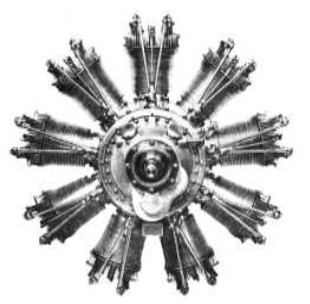
"Clerget, 9-cylinder"
-Continuing with the Diesel engines, there was a 16-cylinder V-engine, with sliding-oscillating sleeves that had ports instead of valves.
-It had four Rateau compressors and in 1939, this engine gave 1,600 CV at 1,400 rpm.
-It was known as "16H" and more colloquially in the factory as "Type Trasatlantique".
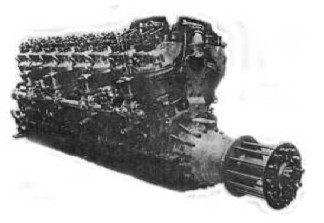
"Clerget 16H"
-Turning back, in 1918, the 16X engine was an engineering test, because its 16 cylinders were in four rows of four cylinders, forming an X.
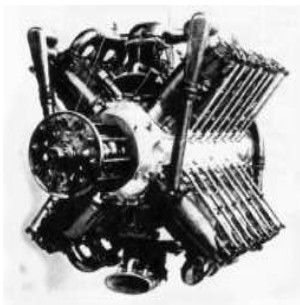
"Clerget 16X"
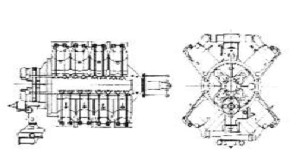
"16X diagrams"
-During the 1930's, Pierre Clerget was the most advanced Frenchman on the subject of aviation diesel engines. The Germans with their Junkers Jumo used opposed pistons, in short, another valid formula. They were from the same time period.
-When P. Clerget died in 1943 the GEHL company with R. Marchal in charge, continued Clerget's work.
-In the MAE Museum Reserve there is a 9AHL. It is a Diesel engine so the HL letters in the denomination may refer to "Huile Lourde". (Heavy Oil)

"Clerget 9AHL"

"Clerget horizontal"
-The same engine as shown further below, controlled by documentation of the time as "Clerget-Clement", in the MAE is only marked as Clerget.
From Appendix 6: Doubtful photograph of a fairing motor that appeared in a magazine as a "Clerget" engine of 100 CV, fitted on a Deperdussin Type P airplane.

"Deperdussin with Clerget"
-It is certainly not feasible to see if it is a Clerget as mentioned. The Type P plane had twin wheels, which do not appear here either. This is a 1911 military aircraft.

"Clerget V8"
-Photo of a V8 located in a USA Museum. See main text.
-Another view of the 200 CV Clerget V8 engine presented at the 1910 Paris Aeronautic Salon.
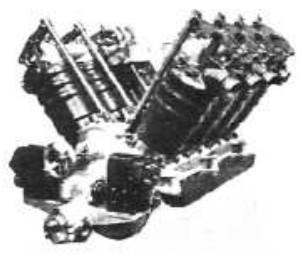
"Clerget V8"
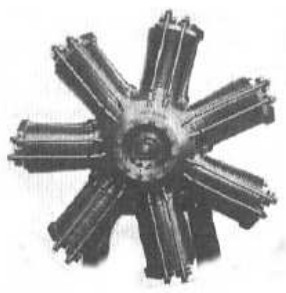
"Clerget rotary 60/70 CV"
-This extension of the text is used to introduce the small 60/70 CV that is mentioned before and is not illustrated.
-From R. Marchal's "Moteurs d'Avions" publication we obtained a variant of the 16-cylinder V-engine, 16H, which also appears in the main text, but in the picture below there are four small turbo-superchargers on top of the engine itself between the two Cylinder banks that form the V.
-They were Rateau turbos. Below we include an illustration of the 16 H and a turbo cut-away diagram.
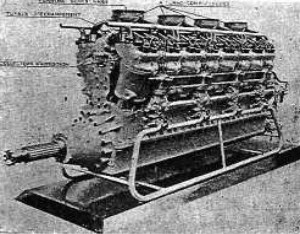
"Clerget 16H turbo supercharged"
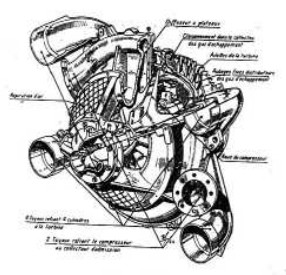
"One of the four Rateau turbos"
-R. Marchal was professor, aeronautical engineer and was in Snecma as well.
-We are provided with more Clerget engine images, which are not previously edited by the A-Z.
-For example, he made automotive engines like the following Clerget for Sultan.
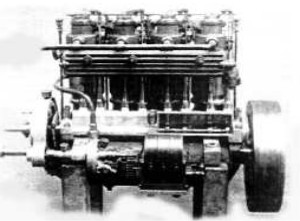
"Clerget automotive engine from 1899"
-Firstly the Clerget-Blin Type 2K with two horizontally opposed cylinders that was intended for light aircraft.
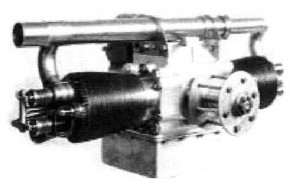
"Clerget 2K, for light aircraft"
-The next engine is little known as well, an inverted in-line, water-cooled six-cylinder.
-It is the 6A model that gave 180 CV, and was built around 1917.
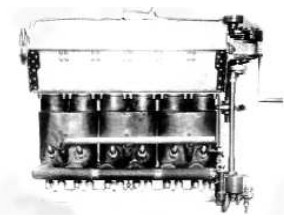
"Clerget 6A"
-This same year 1917 Clerget made the 11-cylinder radial engine, the Clerget-Blin 11Eb that gave 200 CV. This engine was a variant with a special variable compression device of the simpler 11D from 1916.
-The variable compression allowed to fly at 6,000 meters altitude during the bombing of the Krupp factory beyond the reach of anti-aircraft weapons.
-Continuing with the year 1917, Clerget built the 16-cylinder X-engine (the 16X) giving 400 CV with 35 liters of displacement. We have a good illustration.
-The engines of Clerget finally were known for using diesel system, let's say that they acquired a certain specialization. In the next photo we see a characteristic pose of Mr. Clerget next to a radial Diesel engine.
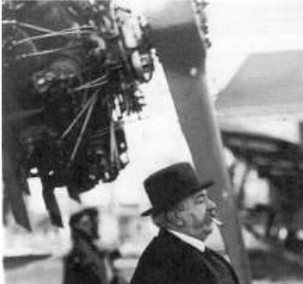
"Mr. Pierre Clerget"
-He made V-prototypes like the 180 CV, 2-stroke / 4-stroke model using Diesel as well. It was an eight-cylinder V-engine.
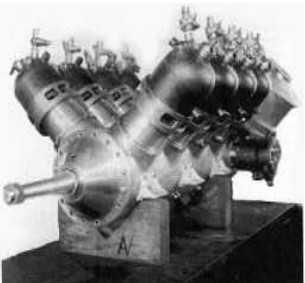
"Nice appearance of the two-stroke Diesel Clerget"
-However, as is mentioned continuously, the known Clerget Diesel engines are radials. Examples such as the 100 CV, 9A model, or the Clerget 14D with 500 CV from 1932.
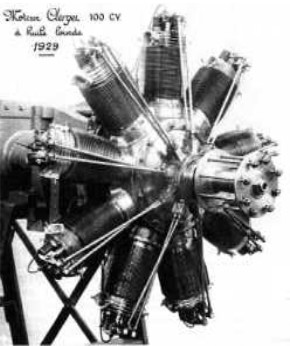
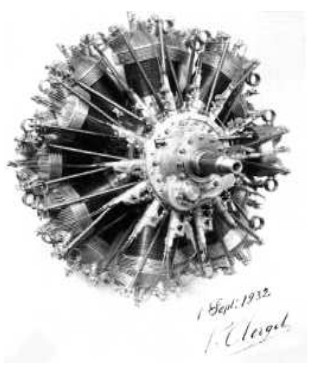
“Clergets 9A and 14D”
From Appendix 7:. Engine from the Kew collection. Photo D. Birch. (AEHS).
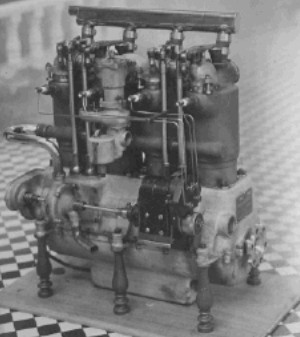
"Clerget, 50 CV"
From Appendix 9: The 50 CV Clerget 4V (see main text) that is exhibited at the Vienna Museum. The front cylinder - or rear according to how you look at it - is sectioned for teaching.

“Clerget 4V, 50 CV” (E-V)
It is mutilated by the lack of magneto and high tension cables (ramps).
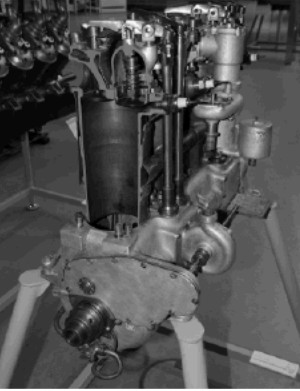
"The sectioned cylinder of the 4V"
-The connecting rod and the piston are also missing.
-In the Clerget and Malicet et Blin chapters of the main text, it is said that some of the engines were made by Malicet, and eventually they even allied, selling the engines as Clerget-Blin.
-A proof of this alliance or union of interests is the four-cylinder engine that is located at the MAE reserve stock in Dugny, just on the opposite side of the runway where the exhibitions at the Paris Air Show have place.
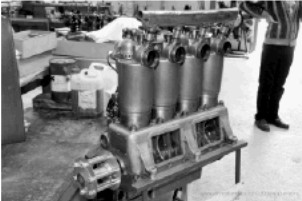
"The magnificent Clerget 4V engine"
-The four-cylinder 4V is enormously beautiful, with its red copper sleeves. The plaque clearly indicates that the Clerget was manufactured by "Malicet et Blin".
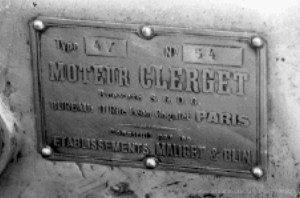
“Revealing plaque of the builder” (E.V.)
From Appendix 10: In the archive of the French Defense Mo ECPAD I located some photos of a Clerget engine construction at the Salmson factory in Billancourt (Hautes-de-Seine).

"Final assembly stage of Clerget-Salmson?"
-Clerget sold licenses to England above all (Humber and Gwynnes). Within France, the Clerget engines were made in collaboration with major automotive brands such as Renault, Clement-Bayard, Delaunay-Belleville, Hispano-Suiza and especially Malicet et Blin. Now we see that with Salmson they made radial engines.
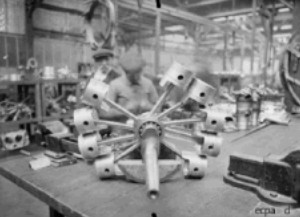
"Workbench with essential engine parts"
-Nice picture of the crankshaft, connecting-rod system and pistons.
-An installation of an inline Clerget engine on an incipient helicopter with contra-rotating rotors. Interesting and well before the known ones.
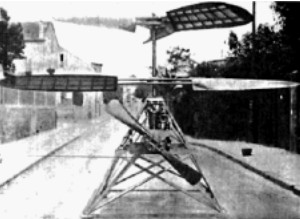
"Pioneering helicopter with Clerget engine"
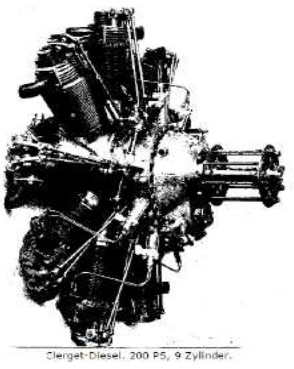
"Clerget Diesel engine, 200 CV"

"Clerget Diesel engine, 100 CV"
-The 200 hp engine's individual injection pumps are visible at the front.
Engines of CLERGET
Model: 11D
Arquitecture: 11-cylinder Radial
Cooling:
Total Displacement:
Bore / Stroke:
Power: @ rpm
Weight:
Model: 11Eb, Eg
Arquitecture: 11-cylinder Rotary
Cooling:
Total Displacement:
Bore / Stroke:
Power: 200 CV @ rpm
Weight:
It was a study engine of an unusual concept that was tested on a Nieuport. This engine was an 11D derivative that has only been bench tested.

"Clerget 11Eb, half-rear view"
Model: 11G
Arquitecture:
Cooling:
Total Displacement:
Bore / Stroke:
Power: @ rpm
Weight:
Model: 14D
Arquitecture: 14-cylinder Radial
Cooling:
Total Displacement:
Bore / Stroke: 140 x 170 mm
Power: 400 CV @ rpm
Weight:

"Clerget 14D"
Model: 14di
Arquitecture: 14-cylinder Radial
Cooling:
Total Displacement:
Bore / Stroke: 140 x 170 mm
Power: 500 CV @ rpm
Weight:
Model: 14E
Arquitecture: 14-cylinder Radial
Cooling:
Total Displacement:
Bore / Stroke: 140 x 170 mm
Power: 450 CV @ rpm
Weight:

"Clerget 14E"
Model: 14F, Fcs, F2
Arquitecture: 14-cylinder Radial
Cooling:
Total Displacement:
Bore / Stroke: 140 x 170 mm
Power: 500 CV @ rpm
Weight:

"Clerget 14F"
Model: 14U
Arquitecture: 14-cylinder Radial
Cooling:
Total Displacement:
Bore / Stroke: 140 x 170 mm
Power: 500 / 640 CV @ 1900 / 2200 rpm
Weight:

"Clerget 14U"
Model: 16 H, diesel V-16
Arquitecture: 16-cylinder V-Engine
Cooling:
Total Displacement:
Bore / Stroke:
Power: 1600 CV @ 1400 rpm
Weight:

"Clerget 16H"
Model: 16 SS, diesel
Model: 16 X
Arquitecture: 16-cylinder X-engine
Cooling:
Total Displacement: 35 Ltr.
Bore / Stroke:
Power: 400 CV @ rpm
Weight:

"Clerget 16X"
Model: 2K
Arquitecture: 2-stroke2-cylinder Horizontally opposed
Cooling:
Total Displacement:
Bore / Stroke:
Power: 16 CV @ rpm
Weight:

"Clerget 2K, for light aircraft"
Model: 4V, 40 CV
Arquitecture: 4-cylinder In-line
Cooling: Liquid
Total Displacement:
Bore / Stroke:
Power: 50 / 63 CV @ 1650 / 1800 rpm
Weight:
It had steel cylinders and red-copper water circulation sleeves that were obtained by electrolysis.

"Clerget, 4V model"
Model: 4W, 40 CV
Arquitecture: 4-cylinder W-engine
Cooling:
Total Displacement:
Bore / Stroke:
Power: 100 CV @ rpm
Weight:
Model: 6A
Arquitecture: 6-cylinder In line inverted
Cooling: Liquid
Total Displacement:
Bore / Stroke:
Power: 180 CV @ rpm
Weight:

"Clerget 6A"
Model: 7Y radial
Arquitecture: 7-cylinder Rotary
Cooling:
Total Displacement:
Bore / Stroke:
Power: 60 CV @ 1200 rpm
Weight:
Model: 7Z radial
Arquitecture: 7-cylinder Radial
Cooling:
Total Displacement:
Bore / Stroke:
Power: 85 CV @ 1200 rpm
Weight:

"7Z, 80 CV"
Model: 8V, 100 CV
Arquitecture: 8-cylinder V-Engine
Cooling:
Total Displacement:
Bore / Stroke:
Power: 100 CV @ rpm
Weight:
Model: 9A radial Diesel
Arquitecture: 4-stroke9-cylinder Radial
Cooling:
Total Displacement:
Bore / Stroke: 130 x 170 mm
Power: 100 CV @ rpm
Weight:
It had a direct injection system for Diesel fuel.

"Clerget 9A"
Model: 9AHL
Arquitecture: 9-cylinder Radial
Cooling:
Total Displacement:
Bore / Stroke: 130 x 170 mm
Power: @ rpm
Weight:

"Clerget 9AHL"
Model: 9B radial Diesel
Arquitecture: 4-stroke9-cylinder Radial
Cooling:
Total Displacement:
Bore / Stroke: 130 x 170 mm
Power: 200 CV @ rpm
Weight:
It had a direct injection system for Diesel fuel.
Model: 9B, Bf
Arquitecture: 9-cylinder Rotary
Cooling: Air
Total Displacement:
Bore / Stroke:
Power: 130 CV @ rpm
Weight:
The pistons were made of aluminum alloy.
The high compression version reached 153 CV.

"Clerget 9B, Diesel"
Model: 9C
Arquitecture: 4-stroke9-cylinder Radial
Cooling:
Total Displacement:
Bore / Stroke: 130 x 170 mm
Power: 300 CV @ rpm
Weight:

"Clerget 9C"
Model: 9J
Model: 9T

"Clerget 9T from 1932"
Model: 9Z
Arquitecture: 9-cylinder Radial
Cooling:
Total Displacement:
Bore / Stroke:
Power: 120 / 123 CV @ 1200 / 1300 rpm
Weight:
Model: Type Trasatlantique, cils. en H
Model: V8, 180-2T
Arquitecture: 2-stroke8-cylinder V-Engine
Cooling:
Total Displacement:
Bore / Stroke:
Power: @ rpm
Weight:
Model: V8, 180-4T
Arquitecture: 4-stroke8-cylinder V-Engine
Cooling:
Total Displacement:
Bore / Stroke:
Power: 180 CV @ rpm
Weight:
Model: V8, 200 CV
Arquitecture: 8-cylinder V-Engine
Cooling:
Total Displacement:
Bore / Stroke:
Power: 200 CV @ rpm
Weight:


